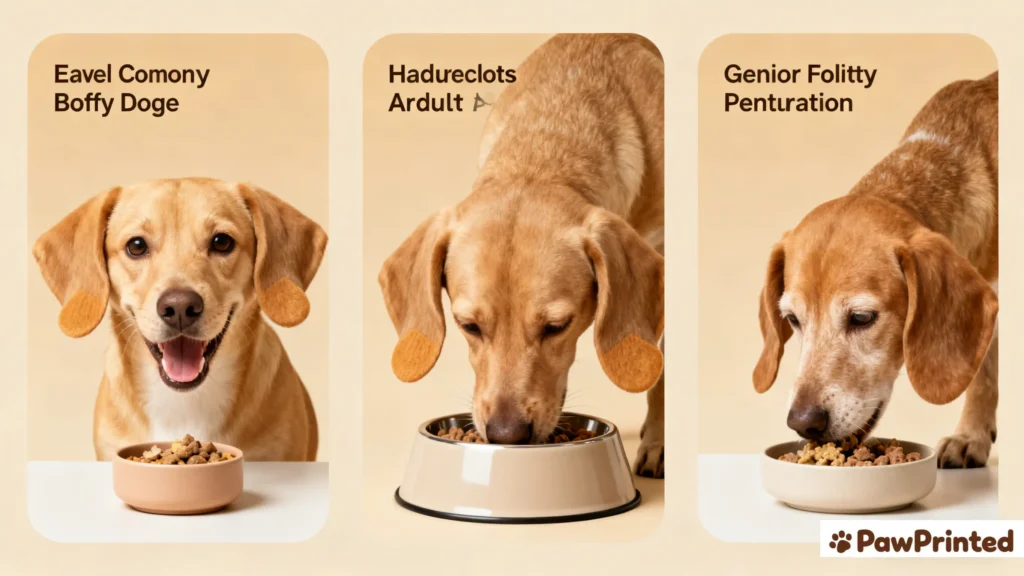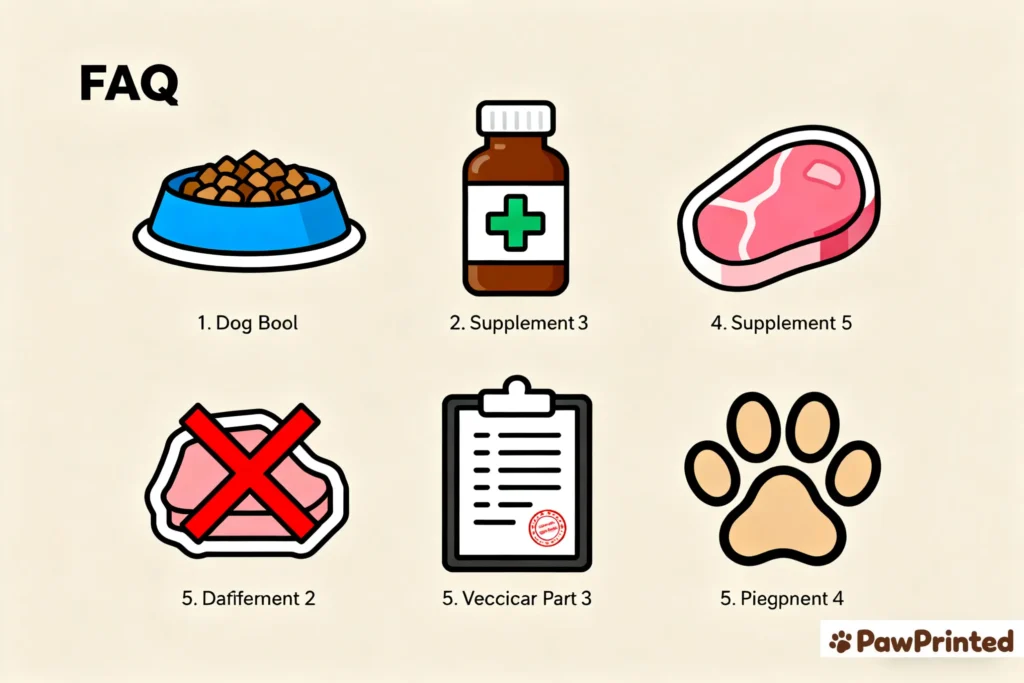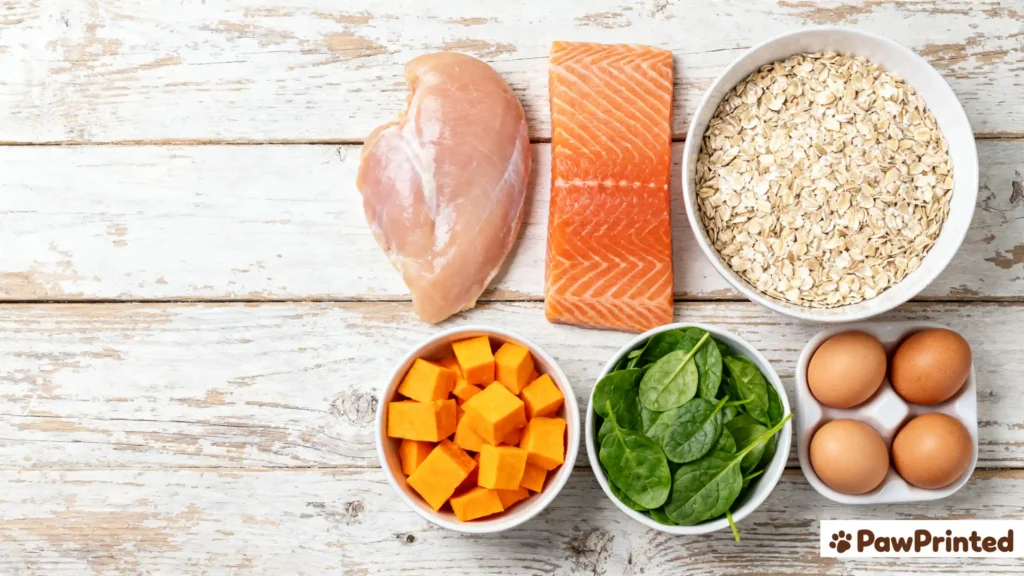Every bowl you fill shapes your dog’s health. Nutrition fuels growth, energy, immunity, and even lifespan. Poor diets, on the other hand, can trigger obesity, joint strain, digestive upset, and low energy. As a dog mom to Ethan — my light-brown, floppy-eared pup with a sensitive tummy — I learned that vet-approved feeding makes all the difference. This guide gathers the fundamentals so you can feed with confidence, too.
Core Nutrition Principles
Protein: Builds muscle, repairs tissue, supports immunity. Best sources: chicken, turkey, salmon, beef, eggs. Avoid fatty scraps or seasoned meats.
Fat: Fuels energy, supports brain and heart health, keeps coats shiny. Omega-3 reduces inflammation, Omega-6 supports skin. Too much fat can lead to obesity.
Carbohydrates & Fiber: Offer steady energy and regulate digestion. Pumpkin, sweet potato, oats, and carrots are excellent. Skip bread, pasta, or sugary snacks.
Vitamins & Minerals: Calcium & phosphorus strengthen bones, Vitamin A supports vision, Vitamin E boosts immunity, while zinc and iron handle repair.
Feeding by Life Stage
Puppies: High protein, controlled calcium, 3–4 meals daily. Steady growth protects developing joints.
Adults: Consistency is key. Two meals daily, measured by calories, adjusted for activity levels.
Seniors: Fewer calories, more fiber, added joint support. Softer meals aid digestion and comfort.
Practical Feeding Tips
Reading Labels: Choose foods where real protein comes first, and look for an AAFCO “complete & balanced” statement.
Portion Control: Feed by calories, not “cups.” A scale or measuring cup ensures accuracy.
Transitioning Foods: Switch gradually over 7–10 days:
| Day | Old Food % | New Food % |
|---|---|---|
| 1–2 | 75 | 25 |
| 3–4 | 50 | 50 |
| 5–6 | 25 | 75 |
| 7+ | 0 | 100 |
Red Flag Checklist: Call your vet if you notice rapid weight change, persistent vomiting or diarrhea, loss of appetite over 24 hours, stiffness or limping, or sudden lethargy.

Special Diet Considerations
Sensitive Stomach: Lean proteins with pumpkin or rice. Small, frequent meals and probiotics can help.
Weight Management: Use calorie-controlled formulas with fiber for satiety. Slow-feeder bowls reduce gulping. Replace high-calorie treats with veggies.
Allergies: Limited Ingredient Dog Foods (LID) with single proteins (duck, salmon) help identify triggers. Avoid common allergens like chicken, beef, or wheat.

Case Study: Ethan’s Journey
Ethan’s sensitive stomach made kibble a daily struggle. Switching to a turkey and pumpkin bowl transformed his digestion. His stools stabilized, his coat shone, and his energy returned. Logging his meals and progress also gave our vet confidence to fine-tune his portions.
FAQ
Raw diets carry bacterial risks. Safer options include lightly cooked homemade meals or commercial balanced raw formulas designed for dogs.
Yes, but keep toppers consistent and adjust calories. Monitor stool quality to avoid digestive upset.
Energy and stool quality often improve within 2–4 weeks. Weight management or joint improvements may take 6–8 weeks.
Some do. Vet-approved probiotics, glucosamine, or fish oil can be beneficial. Avoid human vitamins — they may be unsafe for dogs.
Not necessarily. Some grain-free diets have been linked to heart risks. Most dogs tolerate healthy grains like rice or oats well.

Recommended Products (Vet-Approved)
Hill’s Science Diet Sensitive Stomach & Skin — Gentle formula with prebiotic fiber and vitamin E.
Purina Pro Plan Large Breed (Chicken & Rice) — High protein, joint support, and steady digestion.
Blue Buffalo Healthy Weight — Calorie control, L-carnitine, and balanced fiber for weight-prone pups.
Wellness Complete Health Limited Ingredient — Single-protein recipes for allergy-prone pups.
Vet-Approved Probiotics for Dogs — Supports gut health and eases transitions.

Final Thoughts
Nutrition isn’t about being perfect. It’s about consistent choices that protect your dog’s health day after day. Start simple, stay steady, and let your vet guide adjustments. That’s how we keep tails wagging and energy strong.
What You’ll Find in the Full PDF Guide
If you want extended feeding charts, printable shopping lists, and step-by-step recipes, our Vet-Approved Dog Nutrition PDF is available anytime. It’s built for real-life dog parents who want clarity and practical tools in one place.

